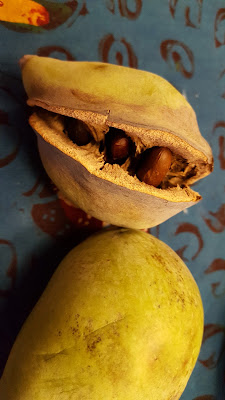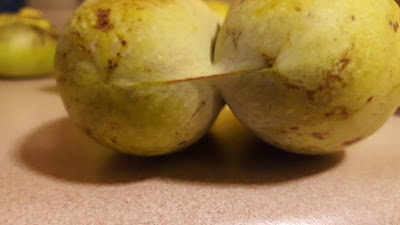In June 2017 I took a census of pawpaw fruits, comparing the 2016 harvest with what I anticipated would be the 2017 harvest.
Here's the information I tabulated and predicted in the census, based on the small pawpaw fruits that were on the trees in June:
The Shenandoah: 65 (last year's final tally: 33)--a predicted increase of 32
The KSU-Atwood: 23 (last year's final tally: 34)--a predicted decrease of 11
The Wells: 37 (last year's final tally: 13)--a predicted increase of 24
The Total: 125 (last year's final tally: 80)--a predicted increase of 45
(For more details on 2016's harvest, see this post.)
But below, I've got the actual, verified, final numbers for you, complete with day-by-day notations on the harvest, which, among all trees, lasted from September 5th to October 31st.
 |
| The Shenandoah gave us 72 pawpaws, beginning on Sept 5th and concluding on Oct 31st, lasting for the full extent of the harvest. |
 |
| The KSU-Atwood gave us 32 pawpaws, beginning on Sept 15th and finishing up just a few minutes after the Shenandoah on Oct 31st. |
 |
| The Wells gave us 66 pawpaws, beginning on Sept 28th and finishing on Oct 26th. On a per-day basis, the Wells's concentrated fury couldn't be matched. And also, like I've said, the Wells was a double-pawpaw making machine (we counted each double pawpaw as two pawpaws, fyi). |
The Shenandoah
- 2016 final tally: 33
- 2017 prediction: 65
- 2017 final tally: 72 (39 more than 2016 and 7 more than predicted)
The Atwood
- 2016 final tally: 34
- 2017 prediction: 23
- 2017 final tally: 32 (2 fewer than 2016 but 9 more than predicted)
The Wells
- 2016 final tally: 13
- 2017 prediction: 37
- 2017 final tally: 66 (53 more than 2016 and 29 more than predicted)
The Total
- 2016 final tally: 80
- 2017 prediction: 125
- 2017 final tally: 170 (90 more than 2016 and 45 more than predicted)
 |
| So much arithmetic in this post. Next time hopefully a little more fractal geometry, which as you'll see from the Mandelbrot set lurking on the other side of the Shenandoah's chart, is the true substrate of all pawpaw harvesting. |














































